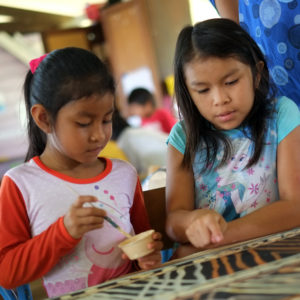
In the commune of Camopi, in French Guyana, Ti’iwan Couchili, the first woman woodcarver, intervenes in primary school to transmit her know-how to young people. These Amerindian children come from the Teko and Wayampi communities. But they often have not followed traditional education and do not speak their language. This is why Ti’iwan shares her knowledge through painting workshops. To give them back their self-confidence.
The Voice of the Native Women and Anne Pastor will also lead two workshops in March 2021, but this time with schoolchildren from Camopi. A suitcase of stories will be created with the sixth grade students and a podcast of identities with the ninth grade students.
A suitcase of stories
To create this suitcase, the children will first write words related to their Amerindian culture, put them in a bag and then draw one at random. They will then investigate these words by interviewing their family, father, mother, grandparents and the elders of their community.
From this material, the children will create a suitcase containing the treasures of Amerindian culture: objects, sounds, drawings, texts collected or written in class. The suitcase will travel from class to class and will grow over time.
Identities Podcast
Words and sounds to tell each other.
Eighth grade students will create a podcast that resembles them, making reports on the theme of culture and interculturality. To do this, they will collect testimonies from the craftsmen of Camopi, but also from the holders of ancestral knowledge.
This approach, which combines participatory journalism and art, is an original work. It is entirely thought out and imagined by the pupils with the help of the local inhabitants and artists.
Heritage at the heart of transmission
These two workshops will thus give an important place to heritage. In these indigenous communities, women are at the centre of the transmission of ancestral knowledge, culture and mother tongue. Even if among the Wayampi, for example, the transmission of stories is traditionally attributed to men, in reality it is women, and especially grandmothers, who tell the stories to their children.
It is also the women who are in charge of making gourds, which are very important in the daily life of the Amerindians. Made from the fruit of the calabash tree, kitchen gourds are decorated with traditional motifs and are used to serve and drink cachiri, an Amerindian alcoholic beverage.
The women are also involved in the preparation of cotton and weaving. Among the Teko, for example, the women wear a “kedju” apron, which they weave themselves. This cotton garment is made of a bead weave. Some girls in Camopi have already been introduced to cotton preparation and weaving of baby carriers through workshops organised at school and led by the elders.
The myth of pottery
Pottery is also an exclusively female activity. “In the myth of pottery, clay presents itself to people as a woman, Kuliweli, who makes and distributes pottery. She is also the one who explains the prohibitions accompanying the making of pottery for pregnant and menstruating women. There is in fact a kind of assimilation between the cachiri jar and the maternal womb, between clay and the female womb”. *
The craftswomen of each community have their own techniques: the Wayampi women make everyday objects, such as bowls or water pots, which they decorate and then cover with a brown plant sap, called tuli, to waterproof the walls. An important ancestral art among the Amerindians.
During these two workshops organized by the voice of the Native Women, the young schoolchildren of Camopi will be able to rediscover this heritage which is theirs, through meetings with the craftsmen and elders of the municipality.
*https://horizon.documentation.ird.fr/exl-doc/pleins_textes/pleins_textes_6/b_fdi_47-48/010010224.pdf


